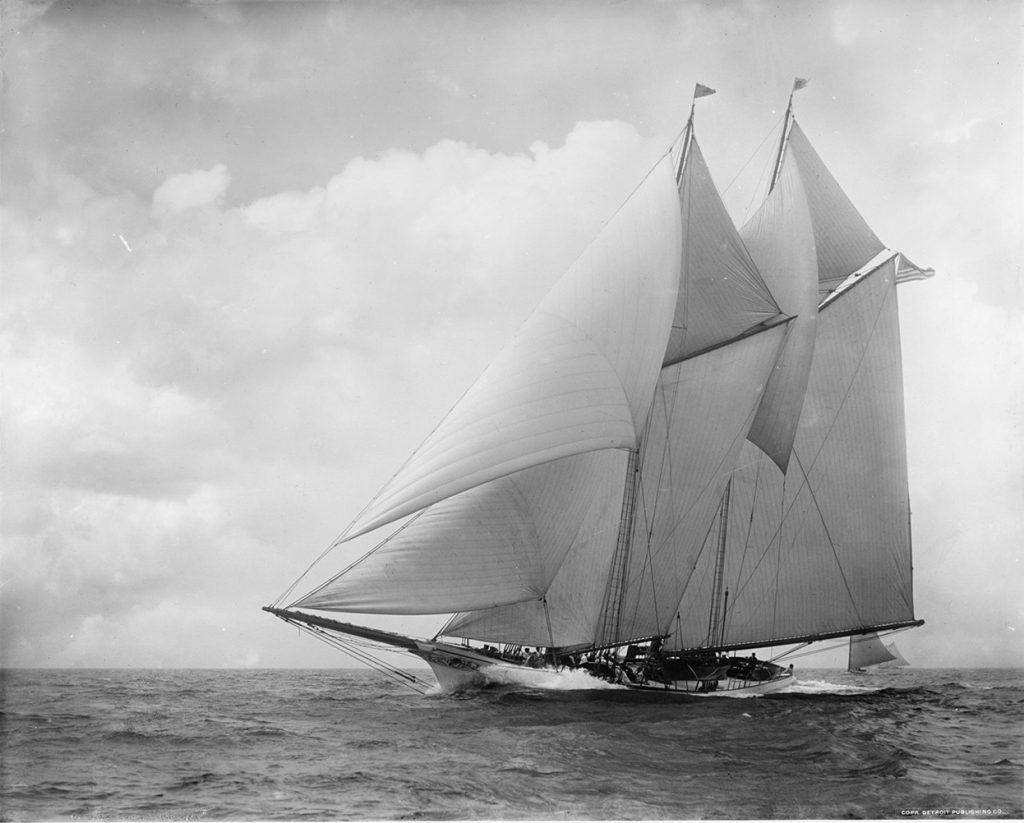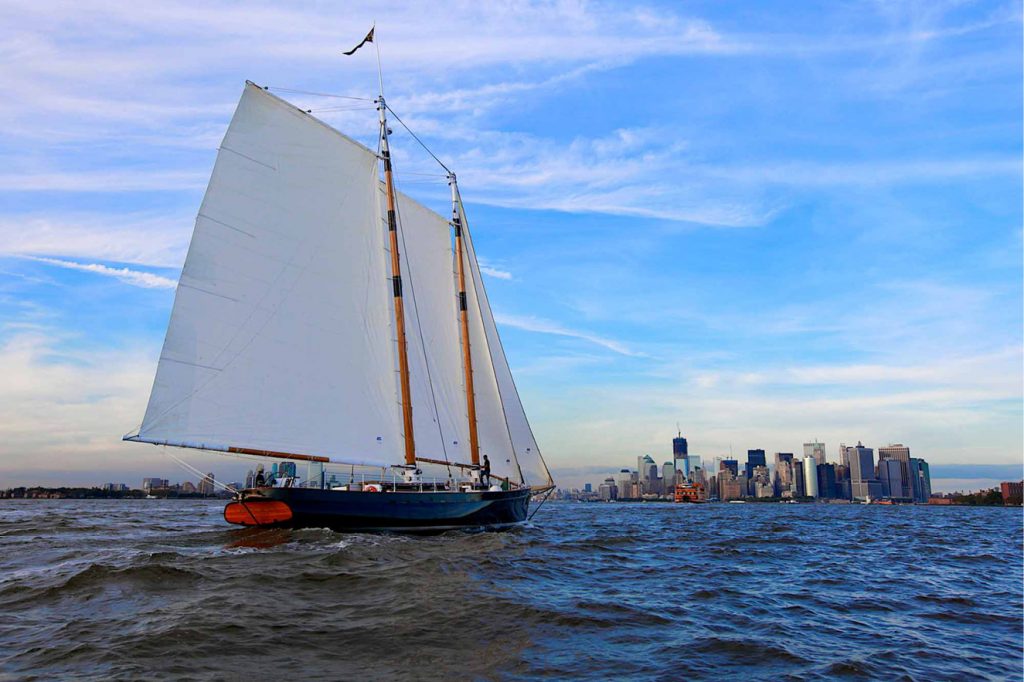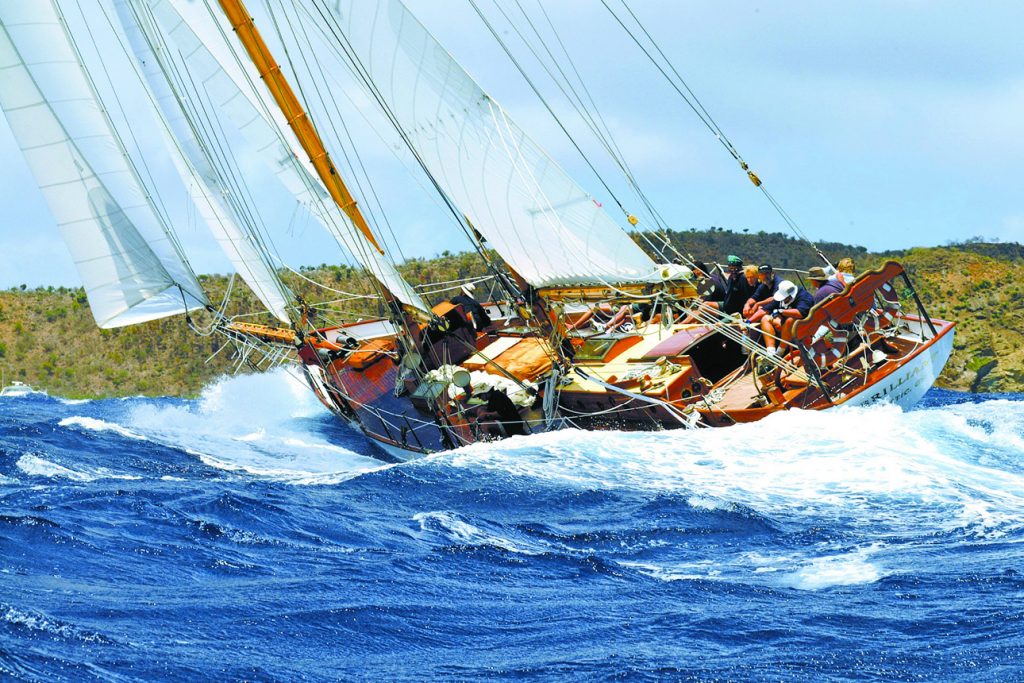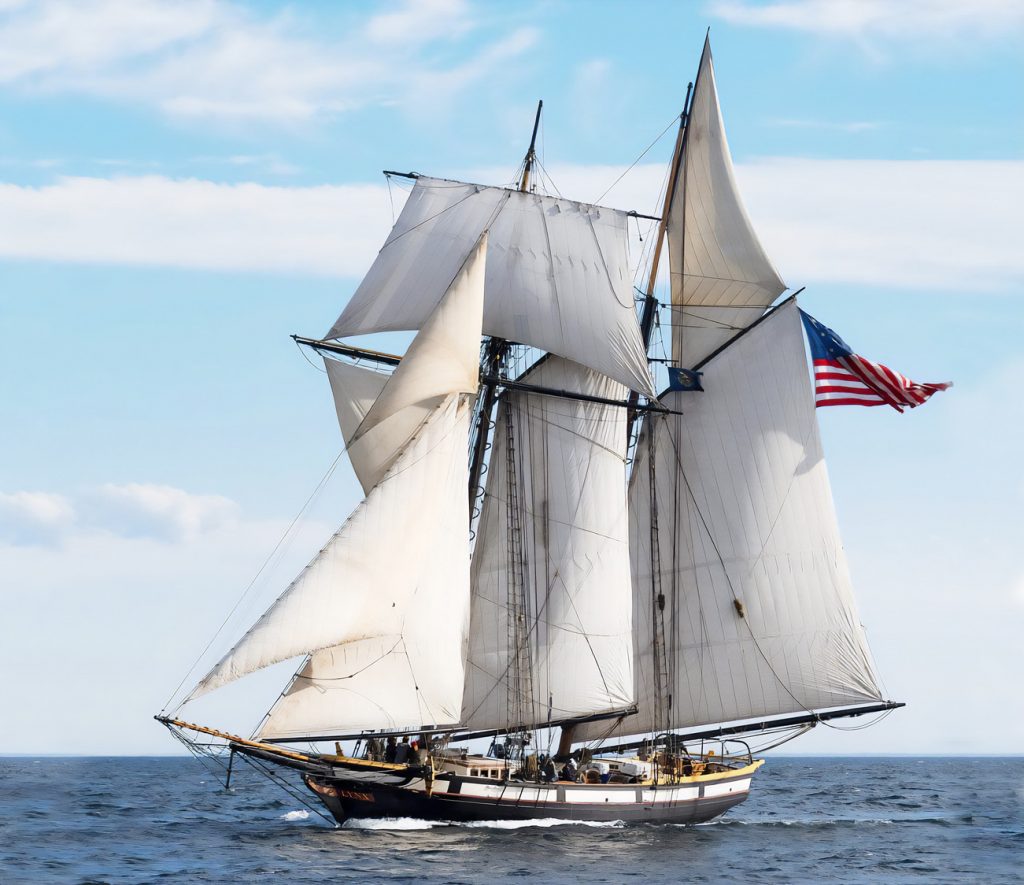“It’s not history. It’s fiction based on fact.”

The Schooner America trounced her British rivals in a race around the Isle of Wight, an event that would become the America’s Cup. © Detroit Publishing Co.
The story of the schooner, America’s first iconic yacht design, often follows along fanciful story lines. From the original America, namesake for the Cup that’s launched a hundred campaigns, to working fishing boats and more recently built craft constructed with modern materials, the schooner is a design mystery tucked in a long-lost history book.
What makes a schooner a schooner? It’s a sailboat built with a minimum of two masts, with the foremast slightly shorter than the first or main mast. While schooners can have more than two masts, most have only two. The origins of the design are believed to be in the mid-1700s, in the environs of New England during the Colonial period. Built for speed and efficiency in coastal cruising, the design of the schooner laid the path for the development of the most famous American ship design, the Clipper Ship.
With its origins in the Chesapeake Bay, the clipper grew in popularity as the older cousin of the schooner. Ironically, with their speed and efficiency schooners became the preferred vessel of pirates, privateers and New England fishermen.
The most famous schooner in yachting was undoubtably America, forever associated with a line no sailing historian can resist repeating: “Your Majesty, there is no second.” That’s what Queen Victoria heard in 1851 after asking for the result of the race in which a pitch-black American schooner trounced the pride of British yachting off the Isle of Wight.
The events surrounding the legend of America involved innovation, reputation and determination. The stories are a dramatic account of the dogged rivalry between old and emerging sea powers. We have drawn extensively from David Gendell’s fascinating yachtograpy of America’s path from birth in 1851 to her undignified 1942 demise in an Annapolis boatyard (The Last Days of the Schooner America, Globe Pequot, 2024) Gendell, a writer and co-founder of SpinSheet, the excellent Annapolis-based sailing monthly, spins the tale of the underdog schooner that crossed the Atlantic and bested the British yachting elite.
New York Creates the America
A syndicate headed by New York Yacht Club’s John Cox Stevens wanted to show England what the United States had to offer on the water. The New York backers were clearly nervous about the radical design that they commissioned from a neophyte naval architect, George Steers. On page 45, Gendell reviews the features of the original schooner, which was white-hulled.

Designed and built by Scarano Boat Building in Albany, NY and launched in 2011, the 105-foot America 2.0 is available for public and private sails out of New York City and Key West (classicharborline.com). © scaranoboat.com
“The America was s sleek, slant-rigged, ghostly white vessel whose design was ironically penned by a virtual nobody of American yacht design, one George Steers. The new schooner was rigged with two dramatically raked masts, the tops of both reaching far astern from their bases in the deck, making them appear to be leaning aft. Those raked masts, specified by Steers to help balance the large sail plan, would feature in all future retellings of her legend. Anchored by her apars, the schooner carried straightforward sail and rigging plans… A unique method of storing iron ballast…was conceived and executed. Most of the ballast was molded into the sides of the hull, just below the waterline.”

Thousands of sailors have earned their sea legs aboard Brilliant, Mystic Seaport Museum’s offshore classroom for seven decades. © mysticseaport.org
“Although vessels of America’s size were typically steered solely with a wheel, the new schooner could also be fitted and steered with a tiller, which would afford a more responsive, more immediate helm during racing. In almost every aspect of her construction and rigging, she was a revelation.” (page 15)
“In nearby New Jersey, sailmakers carefully and expensively built racing sails from machine-made cotton duck that proved far superior to the loosely woven flax sails favored by English racers. Once aboard the schooner, the cotton duck sails were carefully fitted and finished and then stowed away…All passage making and pleasure cruises would be powered by a less exotic set of sails.”
(page 15)
Team America was justifiably nervous; this was an expensive 100-foot boat. The builder, William H. Brown Shipyard, now the site of the FDR PS 32 between present day 11th and 12th Streets at Avenue D in lower Manhattan, charged $30,000. This was one and a half times the price usually paid for a yacht of her size and the equivalent of more than a million dollars in 2024. But the new owners were betting that they had a blue water thoroughbred and a match for any competitor, American or foreign.
“In all conditions and on all points of sail, America moved through the water well balanced and with astonishing speed.” (page 32)
The American Invasion
As planned, America sailed across the Atlantic to Cowes, hoping for some racing action on the Solent. Their arrival came amid the hoopla of Queen Victoria’s “The Great Exposition.” This grand scientific and cultural circus was, for the Queen and her husband Prince Albert, the time and place to showcase British innovation and power. “More than six million visitors flocked to the fair over its five and a half-month run, including celebrities from Charles Darwin to Charles Dickens to Karl Marx.” (page 23)
It seemed to the English yachting elite in London that they could make some quick profitable bets on British yachting. America spoiled the party. “On August 22, 1951, less than 16 weeks after her launch, all doubt about the schooner vanished as America soundly defeated fourteen of England’s finest racing yachts in a 53-mile race, clockwise around the Isle of Wight, in light winds. That even, as a band played “Yankee Doodle,” America’s owners collected the “One Hundred Sovereign Cup,” a 27-inch tall, 134 -ounce bottomless trophy made at Garrards, the Queen’s Crown Jeweler.” (page 31)
“The whole thing went off well,” said James Hamilton, descendant of Alexander and a backer of the America campaign. There are numerous written and anecdotal accounts of America’s first and only major trophy race. Back in the Massachusetts State House, “Daniel Webster, the noted orator and statesman, proclaimed, ‘Little Jupiter among the gods, America is first, and there is no second.’” (page 32)
As a seagoing racehorse, America was a bust. No one would race her again there in the heart of British yachting. Gendell described the somewhat deflated conclusion of America’s racing campaign: “Ten days after her victory, an English nobleman purchased the now painted black schooner for about $25,000. America’s five original owners shared the proceeds of the sale as well as the 100 pounds the schooner won in a two-boat challenge race conducted a few days between the race around the Isle of Wight.” (page 35)
America’s path from 1851 going forward is a historical novel in itself. Brought into the U.S. Navy, she had a colorful history in the Civil War, on both Union and Confederate sides, before becoming an esteemed training vessel at the U.S. Naval Academy, which had moved to Annapolis in 1845. Needing continual maintenance, America became more a patriotic symbol than a practical platform for boating education.
Dave Gendell’s book’s last chapters trace the years leading to the events of winter 1942 when a heavy, wet snowfall crushed the shed in which America’s disintegrating hull was housed. Despite even the endorsement of then President FDR, the resources to put her back together again were not there during World War II.
A Schooner Profile: The Brilliant Legacy
The best-known schooner sailing today in the Northeast is Brilliant. One of Olin Stephens’ early designs, she is 92 years young and has been operating for the past 71 years as the Mystic Seaport Museum’s primary sail training vessel.
Brilliant was built in 1932 for a Walter Barnum. Built by Henry B. Nevins on City Island, she was configured as an ocean racing yacht to compete with the likes of W. Starling Burgess’ Nina (launched 1928 and lost at sea off NZ in 2013) and John Alden’s sleek Malabar designs. In her maiden voyage in 1933, Brilliant set records for a boat her size on the run from Nantucket Lightship to Bishop Rock Light, England.
Briggs Cunningham was the best known early owner. From the time he started racing Stars at the Pequot YC in Southport, CT in the mid-1920s, Cunningham was a keen sailor competing across many classes. (Cunningham’s first love may have been race cars; there is a substantial car museum endowed by him in southern California. But he promised his mother that he wouldn’t race cars while she was alive.)
But from the mid 1920s until he skippered the 12 Metre Columbia to defend the America’s Cup in 1958, Briggs was the pacesetter among American keelboat helmsmen. He commissioned a string of winning 6 Metres from Clinton Crane including Lucie (now owned by Matt Brooks of Dorade fame) and the young Olin Stephens. In 1931, he was a crew member aboard the Stephens family’s Dorade when she won the Fastnet Race.
After World War II, Cunningham bought Brilliant from the U.S. Coast Guard, who had used her to patrol the New England coast for German submarines, with two machine guns mounted on deck. He had her modified with taller masts and self-tacking jibs, but kept the same gaff rigging. In 1953, he donated her to Mystic Seaport to be used as an offshore classroom. The museum replaced the gaff rig with a Bermuda-rigged mainsail, and it remains the same today. A half model tacked over the doorway of a building by Mystic’s Dyer Dhow fleet shows her features.
Despite her traditional schooner rig, Brilliant has all the characteristics of a full-bodied offshore hull, with the graceful ends of a Stephens design. She was the first vessel to receive a Cunningham downhaul, an improved rig invented by Briggs. To my knowledge, other than the Harken block and the Elvstrom bailer, the Cunningham is the only sailboat hardware named for its inventor.
Brilliant: Training Youth at Sea for a Century
In 2023, Sarah Armouth, the Cornell grad and young captain of Mystic Seaport Museum’s Brilliant, put down in words her feelings about her charter and her mission: “Brilliant has taken thousands of students to sea, sailing the equivalent of five times around the globe and impacting the self-confidence, self-esteem and direction of many youth along the way…From Brilliant’s transatlantic record in 1933 to the schooner’s current role operating as one of the oldest sail training programs in the country, Brilliant has a storied legacy.”
Very soon, Mystic Seaport Museum will be embarking on the campaign to refit Brilliant for her next century. She needs a new engine and a thorough refit of frames and keel bolts. This, along with the prospective opening of the West Boat Hall displaying hundreds of archived watercraft, are the important milestones that MSM seeks to support with member donations.
Brilliant is a schooner I have had the pleasure of sailing.
I was sailing with Sarah and other sailors from the Larchmont Yacht Club on a very rare sunny and gently breezy early June day on Long Island Sound. Roaming the deck of a 30-ton vessel implies stability, but all of those steering her remarked on her responsiveness and absolute speed. Reaching under gaff rig is delightful. One never spills one’s drink.
Schooners at the 2024 Opera House Cup
In this year’s Nantucket Opera House Cup, Spirit, a 62-foot Alden schooner built in 1934, came within half a football field of winning that pursuit format event, one-third of which was a one tack beat. Flying four sails in 10-15 knots of close reaching, Spirit came close to passing the four Alerions that finished first to fourth overall.
Trailing Spirit in the Opera House standings were two very different designs built almost 70 years apart. First came Eros, a 114-foot staysail schooner built in Lowestoff, England at the outbreak of WWII. With an immense mizzen mast, she sported an interior for a Gilded Age mogul. She did not win the 2024 race but clearly won the cocktail party, looking pretty on Old North Wharf.
Launched in 2003, schooner Juno is a modern boatbuilder’s boat. The rig is traditional, but the hull has the construction and lines of a new style vintage design. Nat Benjamin of Gannon and Benjamin, the Vineyard Haven yard that works on so many vintage craft, gets to show his artistry in Juno.
One cannot forget Lynx, America’s Privateer, history racing with her diminutive competition in the Opera House. Any visitor to Nantucket coming up the channel sees Lynx anchored squarely in front of them. One hundred twenty-two feet and launched in 2001, Lynx is a Baltimore clipper, and when her crew can put up all the laundry, this fleet feline can hit double digit speeds on reaches. Tall Ship Lynx enjoys a partnership with Egan Maritime Institute in Nantucket, where local historian Nat Philbrick started his prolific career in the wake of historical novelist Edward Stackpole. One of my good friends helped deliver Lynx from her wintering spot on the Georgia coast in April 2023, up to Nantucket through a spring nor’easter. She said Lynx could take a beating and keep on ticking. That’s a recipe for one vintage schooner.

A modern interpretation of an actual privateer built in 1812, Lynx is the flagship of Tall Ship Lynx (tallshiplynx.org), an educational organization dedicated to hands-on programs that teach the history and present examples of America’s struggle to preserve its independence. © Tyler Fields
Where Schooners Come to Play
The geographic breadth and variety of events where the schooner is the featured design is remarkable. Three top events are the Richard Mille Cup in the UK, the Gloucester Schooner Festival (the 40 Annual GCF was held August 28 – September 1), and The Great Chesapeake Bay Schooner Race, taking place October 2 – 6. The public can view the fleet dockside in Baltimore and Norfolk, and supporters can book passage aboard a schooner on the race segments. The learn more, log onto gcbsr.org. We look forward to following up on the action for the sequel: “Schooner Mania, Part II.” In the meantime, when you’re in port, go up and say hello to a schooner. ■
Not a formally trained historian nevertheless a boat storyteller, collecting and reciting stories for the boating curious, Tom Darling hosts Conversations with Classic Boats, “the podcast that talks to boats.” Tune in via Apple Podcast, Google Podcast or Spotify, or online at conversationswithclassicboats.com.



